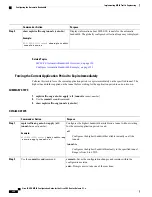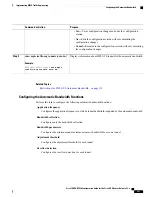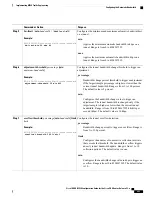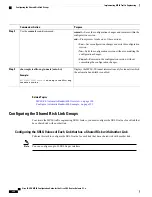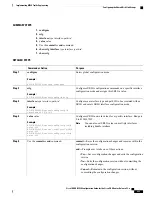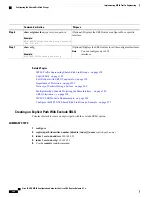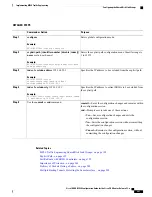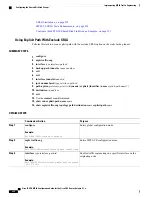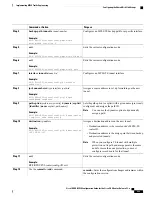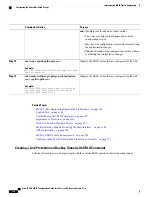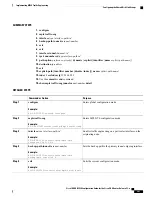
DETAILED STEPS
Purpose
Command or Action
Enters global configuration mode.
configure
Example:
RP/0/RP0/CPU0:router# configure
Step 1
Configures an MPLS-TE tunnel interface and enables traffic engineering
on a particular interface on the originating node.
interface tunnel-te tunnel-id
Example:
RP/0/RP0/CPU0:router(config)#
interface
Step 2
tunnel-te 6
Assigns a source address so that forwarding can be performed on the
new tunnel.
ipv4 unnumbered type interface-path-id
Example:
RP/0/RP0/CPU0:router(config-if)#
ipv4
Step 3
unnumbered Loopback0
Configures the bandwidth required for an MPLS TE tunnel. Because
the default tunnel priority is 7, tunnels use the default TE class map
(namely, class-type 1, priority 7).
signalled-bandwidth
{
bandwidth
[
class-type
ct
] |
sub-pool bandwidth
}
Example:
RP/0/RP0/CPU0:router(config-if)#
Step 4
signalled-bandwidth 10 class-type 1
Enables messages that notify the neighbor nodes about the routes that
are forwarding.
autoroute announce
Example:
RP/0/RP0/CPU0:router(config-if)#
Step 5
autoroute announce
Assigns a destination address on the new tunnel.
destination ip-address
Step 6
Example:
RP/0/RP0/CPU0:router(config-if)#
•
Destination address is the remote node
’
s MPLS-TE router ID.
•
Destination address is the merge point between backup and
protected tunnels.
destination 10.1.1.1
Configures PBTS to direct traffic into specific TE tunnels or default
class.
policy-class
{
1
-
7
} | {
default
}
Example:
RP/0/RP0/CPU0:router(config-if)#
Step 7
Multiple EXP values can be specified as part of a policy-class, separated
by spaces. The EXP values configured to a TE tunnel effectively form
a monolithic policy-class, which should not overlap with other
policy-class 1
policy-classes. Once an EXP value is used in a policy-class
configuration, it can only be reused if the subsequent policy-class
Cisco IOS XR MPLS Configuration Guide for the Cisco CRS Router, Release 5.1.x
287
Implementing MPLS Traffic Engineering
Configuring Policy-based Tunnel Selection


















